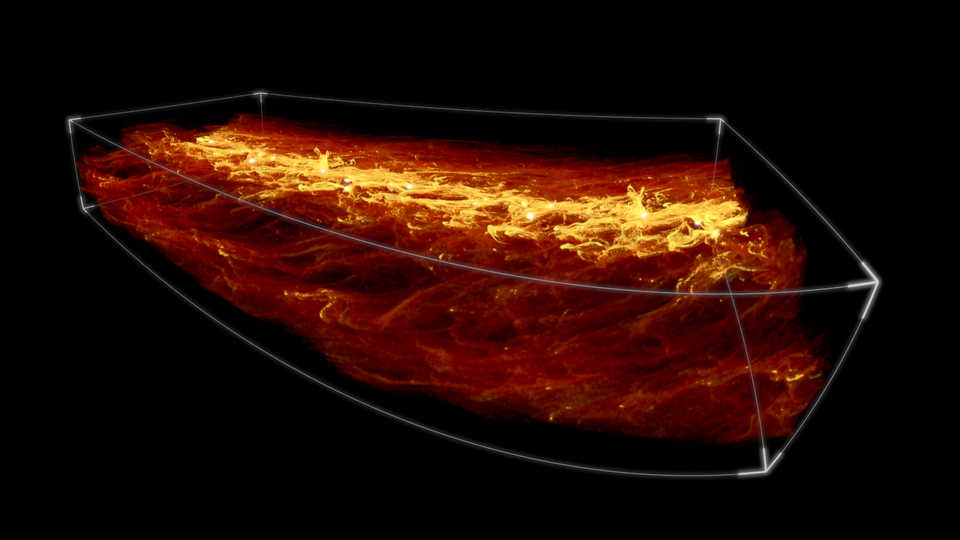Science News
Making Planets

Planets are plentiful, but how do they form? The Universe clearly knows how to make planets (and a lot of ’em, since we have discovered thousands relatively close to home), but we do not. Not that we’re going to whip up a batch of planets like homemade cookies, but we don’t even know the recipe!
At the 227th Meeting of the American Astronomical Society (AAS) held this week in Kissimmee, Florida, exoplanets are a hot topic as always, but the question of how exoplanets formed—indeed, how planets including our own formed—is also getting plenty of attention.
We know the story starts with dusty disks of material: we even see these disks around many stars. But how to go from dust grains to planets presents some challenges (a bit like knowing the ingredients of a soufflé without knowing how to get it to rise). So to begin with, astronomers are observing the dusty disks where planets form.
Dominique Segura-Cox of the University of Illinois described her work “Hunting for the Youngest Protostellar Disks with the VLA Nascent Disk and Multiplicity (VANDAM) Survey.” The recently-completed survey used the Very Large Array (VLA) in New Mexico to observe nearly 100 young stars in the Perseus star-forming region. This is a bit like poking your head into the hospital nursery to understand how babies develop (please don’t mix that up with the baking analogy above): these infant stars can tell us what’s happening very early on in these stars’ lives. In many of these young systems, 90% of the star’s light is blocked by dust! Observations at radio wavelengths (such as those observed by the VLA) allow astronomers to see the bit of light that escapes the stellar infants.
Before the VANDAM survey, we knew of only three disks around such young stars, but about 25 percent of VANDAM young protostars have spatially-resolved disks (i.e., disks big enough to see). And because of the wavelength of light selected, they are observing “pebbles and peas, not dust grains,” according to Segura-Cox. (Note that she’s not talking about actual Pisum sativum but rather pea-sized objects…) And the actual percentage of young stars with disks is probably much larger, since there are likely many smaller disks that the VLA could not resolve.
These are encouraging results, since the extremely young stars in the Perseus star-forming region are already showing signs of forming planets. Or as Segura-Cox put it, the data suggest that these stars are getting a “head start to planet formation at early times.” A press release from the National Radio Astronomy Observatory describes her work—and gives a good summary of what we know about planetary formation.
Jake Simon, Sagan Fellow at the Southwest Research Institute, spoke on a more theoretical plane. He work focuses on making planets—or more specifically, planetesimals, the building blocks of planets—using computer simulations. (One of Simon’s models will actually appear in the Academy‘s new planetarium show, Incoming! Coming soon to Morrison Planetarium, premiering March 11, 2016. A new, live Hohfeld Hall program, “Galaxy of Worlds,” describing our current understanding of planet formation, will premiere the same day.) The challenge is getting from Segura-Cox’s “pebbles and peas” to objects a few kilometers in size or larger…
Simon outlined the two major factors to overcome. First, small stuff (slightly larger than the peas and pebbles, more like softballs) should interact with gas in the disk and fall into the parent star quickly, leaving little time for the peas to grow into softballs to grow into boulders to grow into… You get the picture. Second, in laboratory tests, those pea- and pebble-sized objects have a tendency to break apart or bounce off one another, never getting to the point where they can form bigger stuff.
Simon and his collaborators work around these problems by implementing streaming instability in their computer simulations. “Instead of particles just feeling the headwind of the gas, the gas feels the tailwind of the particles,” Simon said, comparing it to the way bicyclists form a peloton to reduce wind resistance, so the “clumps provide the most aerodynamic configuration.” Ultimately, this allows the simulation to form planetesimals (or at least the predecessors of planetesimals, those boulder-sized objects I mentioned earlier). The simulations also seem to match what we see in our own solar system, namely in terms of the distribution of sizes of asteroids and Kuiper Belt Objects.
So while we may not have pinned down all the details in the recipe for making planets, we certainly know the ingredients, and we have an increasingly clear understanding of how they come together to create the worlds we’re finding around thousands of other stars—as well as the world we call home.
Image: Jake Simon's model of planetesimal formation, from Incoming!